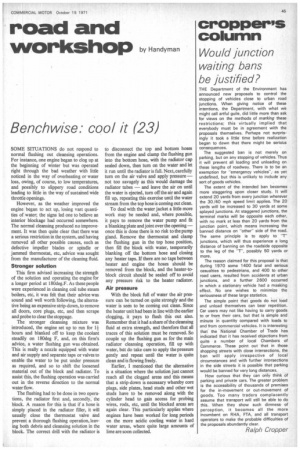• road and
Page 51

If you've noticed an error in this article please click here to report it so we can fix it.
workshop by Handyman
Benchwise: coo/it (23)
SOME SITUATIONS do not respond to normal flushing out cleansing operations. For instance, one engine began to clog up at the beginning of winter but was operated right through the bad weather with little noticed in the way of overheating or water loss, owing, of course, to low temperatures, and possibly to slippery road conditions leading to little in the way of sustained wide throttle openings.
However, as the weather improved the engine began to act up, losing vast quantities of water; the signs led one to believe an interior blockage had occurred somewhere. The normal cleansing produced no improvement. It was then quite clear that there was a serious restriction in the system, and having removed all other possible causes, such as defective impeller blades or spindle or jammed thermostat, etc, advice was sought from the manufacturer of the cleaning fluid.
Stronger solution This firm advised increasing the strength of the solution and operating the engine for a longer period at 180deg.F. As these people were experienced in cleaning coil tube steam boilers, etc, it was felt that their advice was sound and well worth following, the alternative being an expensive strip-down, to remove all doors, core plugs, etc, and then scrape and probe to clear the stoppage.
The stronger cleansing mixture was introduced, the engine set up to run for hours and blanked off to keep the coolant steadily on 180deg F, and, on this firm's advice, a water flushing gun was obtained. This is really a nozzle equipped with water and air supply and separate taps or valves to enable the water to be put under pressure as required, and so to shift the loosened material out of the block and radiator. To assist this, the flushing operation was carried out in the reverse direction to the normal water flow.
The flushing had to be done in two operations, the radiator first and, secondly, the block. A reason for this is that if a hose is simply placed in the radiator filler, it will usually close the thermostat valve and prevent a thorough flushing operation, leaving both debris and cleansing solution in the block. The correct drill with the radiator is to disconnect the top and bottom hoses from the engine and clamp the flushing gun into the bottom hose, with the radiator cap sealed down, then turn on the water and let it run until the radiator is full. Next, carefully turn on the air valve and apply pressure—not too savagely as this would damage the radiator tubes — and leave the air on until the water is ejected, turn off the air and again fill up, repeating this exercise until the water stream from the top hose is coming out clean.
To deal with the water jacket a little more work may be needed and, where possible, it pays to remove the water pump and fit a blanking plate and joint over the opening— once this is done there is no risk to the pump gland. Remove the thermostat and clamp the flushing gun in the top hose position, then fill the block with water, temporarily blanking off the bottom hose and closing any heater taps. If there are no taps between heater and engine the hoses should be removed from the block, and the heater-toblock circuit should be sealed off to avoid any pressure risk to the heater radiator.
Air pressure With the block full of water the air pressure can be turned on quite strongly and the water is seen to be coming out clean. Since the heater unit had been in line with the earlier clogging, it pays to flush this out also. Remember that it had a share of the cleansing fluid at extra strength, and therefore that all traces of this solution must be removed. So couple up the flushing gun as for the main radiator cleansing operation, fill up with water, but do take care to apply the pressure gently and repeat until the water is quite clean and is flowing freely.
Earlier, I mentioned that the alternative is a situation where the solution just cannot reach all the clogged areas and this means that a strip-down is necessary whereby core plugs, side plates, head studs and other wet studs have to be removed along with the cylinder head to gain access for probing wires, rods, etc, until the blocked areas are again clear. This particularly applies where engines have been worked for long periods on the more acidic cooling water in hard water areas, where quite large amounts of lime are soon collected.
















































































































